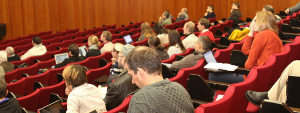2012 will be a decisive year for particle physics and the linear collider projects. What will be the outcome of the update of the European strategy for particle physics? In light of CERN’s Large Hadron Collider (LHC) 2012 results, will the linear collider physics case stay strong?
The international community of theorists and experimentalists working on ILC and CLIC are convinced it will be even stronger and they’re working hard at demonstrating it. More than one hundred of them gathered at DESY last week for three days of intense discussions and review of the different physics scenarios. Besides and complementary to the physics chapters of the ILC Technical Design Report and CLIC Conceptual Design Report, two papers are now underway to make the strongest possible case for a generic linear collider.
The Linear Collider Forum is traditionally aimed at the German linear collider community, as an initiative of the Helmholtz Alliance “Physics at the Terascale”.
“Because this year is special, we invited our colleagues from abroad and focused our discussions specifically on linear collider phenomenology,” said Gudrid Moortgat-Pick, a theorist from the University of Hamburg and co-chair of the forum.
An important part of the meeting was dedicated to a thorough review of brand new LHC results, with presentations from the ATLAS and CMS collaborations on the Higgs, top physics, supersymmetry and searches for exotic new physics. ILC and CLIC phenomenologists presented their latest results on benchmark studies, which shows the linear collider detector performances. They reviewed important physics scenarios and addressed the main questions that can be answered by a linear collider, including those that cannot be addressed by the LHC.
“A precision machine, the linear collider, is needed for example to fully identify and understand the Higgs boson, whatever its mass will be revealed to be,” said Sabine Riemann from DESY Zeuthen, co-chair of the forum.
A key discussion during the forum was how to share these results with the particle physics community and how to make the linear collider physics case clear independently of which machine (ILC or CLIC) would eventually run the beams.
Two papers are now under preparation.
In the first one, the forum aims at compiling the contributions to the workshop into a thorough 100- to 150-page review article. It is planned to be submitted by this summer to the European Physical Journal. The paper will cover many different physics scenarios, without a detailed comparison of the relative performance of the respective machines. The physics motivation for a linear collider will be demonstrated, exploring Higgs and top physics, Standard Model precision measurements and of course physics beyond the Standard Model.
As reflected in the presentations during the forum, this review paper will demonstrate that all types of measurements needed for new discoveries and full scans of LHC results are actually within reach at a linear collider. “Everybody from the particle physics community is warmly welcome to participate in the writing of this paper so that we can draw the clearest and most comprehensive picture of the field,” said Moortgat-Pick. Those interested in contributing are invited to contact the LC forum chairs as early as possible. A dedicated website is now in place for more information: lcforum.desy.de
The second paper was briefly presented during the forum and will be considered as the official linear colliders input for the European Strategy Group. It will be delivered before the end of July to the European Strategy Preparatory Group by the Global Design Effort European Regional Director Brian Foster, CERN Linear Collider Studies Leader Steinar Stapnes and the chair of the ECFA Study for the Linear Collider, Juan Fuster. An international and dedicated ILSCS subcommittee, chaired by François Le Diberder (LAL, France) is in charge of drafting this very short 15-page document, with the help of the community.
Frank Simon from the Max-Planck-Institute of Physics, Munich, co-chair of the forum, was (happily) surprised by the success of the forum with participants coming from all over the world and from both ILC and CLIC communities. “You could feel optimism in our community,” he said. “2012 is a busy and decisive year for us with exciting LHC results ahead, the release of the ILC Technical Design Report, the CLIC Conceptual Design Report, the European strategy for particle physics and the emergence of Japan’s interest in hosting the ILC!”
Simon, together with the LC-Forum team, is also welcoming the common approach of ILC and CLIC in writing a global case for a linear collider. “We need a precision machine to complement the LHC,” he said. “At which energy, we hope Nature will tell soon. In the meantime we need to get ready.”
—–
Further links:
- Linear collider forum website
- 2012 Linear collider forum agenda and slides
- Further reading in ILC NewsLine: “Is the Higgs enough?”



Recent Comments